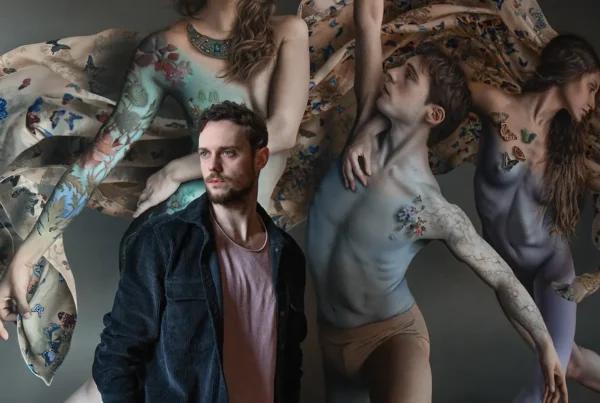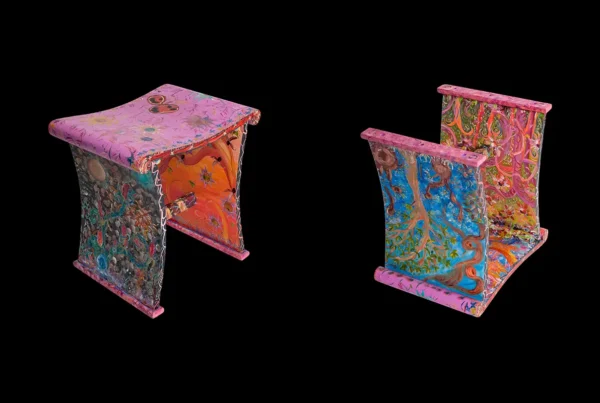“On a perfect day, I will usually fast and eat only later at night when all the work has been done and the brushes have been washed. Fasting gives me a lot of sharpness creatively and makes it easier to get in that perfect state in order to advance a painting. I see it as an aid to make space within myself and welcome a certain peace that helps me resolve the painting. It’s been practiced traditionally in many countries for thousands of years to find guidance and I think it works wonders in an artistic setup.”
From Family Roots to Personal Revelations
Peter Taumate, a 26-year-old artist from Montreal, Canada, carries a rich legacy of creativity within his veins. Growing up in a family where painting and music were constants, Peter was immersed in a world of artistic expression from a young age. His father, a talented painter, singer, and songwriter, balanced his creative pursuits with family responsibilities, providing a nurturing environment for Peter and his siblings. This familial influence instilled confidence in Peter, demonstrating that one can successfully pursue artistic passions while maintaining a balanced family life. It was in this vibrant, supportive environment that Peter first picked up a guitar, setting the stage for his future endeavors.
Interestingly, Peter’s initial artistic inclinations leaned more towards music than painting. His early childhood was dominated by melodies and rhythms, a testament to the musical atmosphere fostered by his father. He and his older siblings eventually formed a band, blending their individual talents into a harmonious collective. However, painting remained a peripheral yet admired aspect of his family’s creativity. It wasn’t until a few years ago that Peter, surrounded by a lineage of painters, found his own love for the medium, adding another dimension to his artistic identity.
The late discovery of his passion for painting marked a significant shift in Peter’s creative journey. Despite being constantly exposed to painting, it took years for him to truly appreciate and embrace it as his own. This transition highlights the dynamic nature of artistic growth, where influences can subtly shape one’s path, only to reveal their full impact later in life. Peter’s story is a testament to the idea that artistic exploration is an evolving process, often guided by familial legacy and personal discovery.

Peter Taumate: Channeling Musical Energy into Visual Art
Peter Taumate’s journey into painting was profoundly influenced by his deep-rooted connection to music. He realized that the emotional and creative energy required to compose a song was remarkably similar to the process of creating a painting. This revelation bridged the gap between his musical and visual artistic expressions, opening new avenues for his creativity. The act of channeling energy into tangible forms, whether through melodies or brushstrokes, became a shared essence of his artistic practice.
This newfound understanding transformed Peter’s approach to painting. He began to see the canvas as a playground for the same emotions and creative impulses that he had previously reserved for music. Each brushstroke became a note in a symphony of colors, each painting a composition in itself. The process of resolving a painting mirrored the journey of composing a song, where the initial chaos gradually finds harmony. This parallel allowed Peter to explore painting with the same fervor and dedication he had for music, enriching his artistic repertoire.
Peter’s exploration of painting soon evolved into a profound and personal experience. The transition from music to painting was not just a change in medium but an expansion of his artistic identity. His paintings started reflecting the same passion, intensity, and emotional depth that characterized his music. This blending of art forms exemplifies how different creative expressions can influence and enhance each other, leading to a richer and more holistic artistic journey.

Faces in Focus: Exploring Portraiture and Abstraction
In his artistic endeavors, Peter Taumate has gravitated towards portraiture, a genre that allows him to delve deeply into the complexities of human expression. His approach to portrait painting is unique, aiming to balance abstract elements with anatomical accuracy. Peter’s technique involves limiting brushstrokes, which lends an abstract quality to his work while maintaining the integrity of the human form. This delicate balance creates a dynamic interplay between abstraction and realism, making each portrait a captivating study of light, emotion, and expression.
The fascination with faces lies in their ability to convey a wide range of emotions through subtle changes in light and shadow. For Peter, this variability is both a challenge and an inspiration. He never knows how a face will evolve on the canvas, as the expressions shift with each brushstroke. This unpredictability adds a layer of excitement to his work, where the final outcome is as much a surprise to him as it is to the viewer. It is this process of discovery and resolution that drives his passion for portrait painting.
Peter’s portraits are more than just representations of individuals; they are explorations of the human condition. Each painting captures a moment in time, an emotion, or a fleeting expression, inviting viewers to connect with the subject on a deeper level. The abstract elements in his work challenge viewers to look beyond the surface and interpret the underlying emotions. This engagement between the artwork and the audience is a testament to Peter’s ability to create pieces that resonate on an emotional and intellectual level.

Peter Taumate: The Art of Creating Space
Peter Taumate’s creative process is deeply influenced by his need for a conducive workspace and his methods for handling distractions. He acknowledges that inspiration cannot be forced and that maintaining focus is crucial for his artistic productivity. For Peter, art is not just a task but a source of joy, and he ensures that his workspace reflects this philosophy. He prefers solitude when creating, often accompanied by music that he enjoys, such as The Who, Joni Mitchell, or Piero Umiliani. This combination of solitude and music creates an ideal environment for his artistic endeavors.
Fasting plays a significant role in Peter’s creative routine, providing him with mental clarity and sharpness. By fasting and eating only later in the day, he believes he can achieve a heightened state of creativity, allowing him to delve deeper into his paintings. This practice, rooted in ancient traditions, helps him find inner guidance and focus, essential elements for advancing his work. Peter views fasting as a means to create space within himself, making room for the creative energy needed to resolve his paintings.
Peter’s approach to handling distractions highlights his understanding of the importance of balance in an artist’s life. He accepts that distractions are a natural part of life and believes that art can serve as a remedy for these interruptions. By embracing his talents and using them as a form of solace, he manages to navigate through periods of distraction. This philosophy underscores the therapeutic nature of art, where the act of creating becomes a sanctuary from the chaos of everyday life. Peter’s ability to blend his artistic process with personal well-being exemplifies a holistic approach to creativity.






